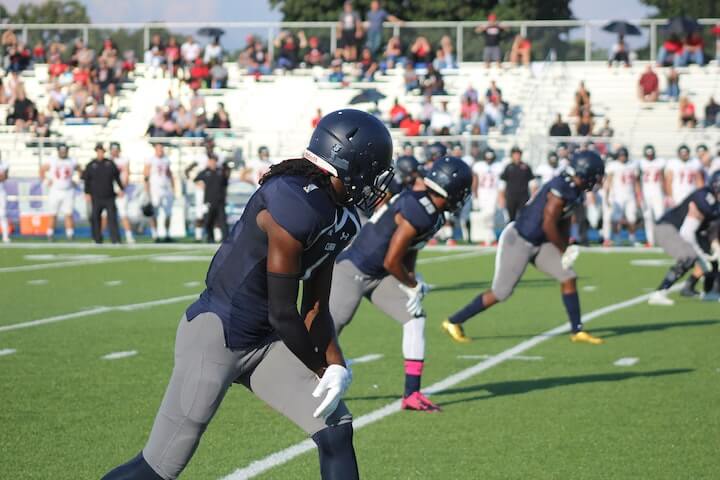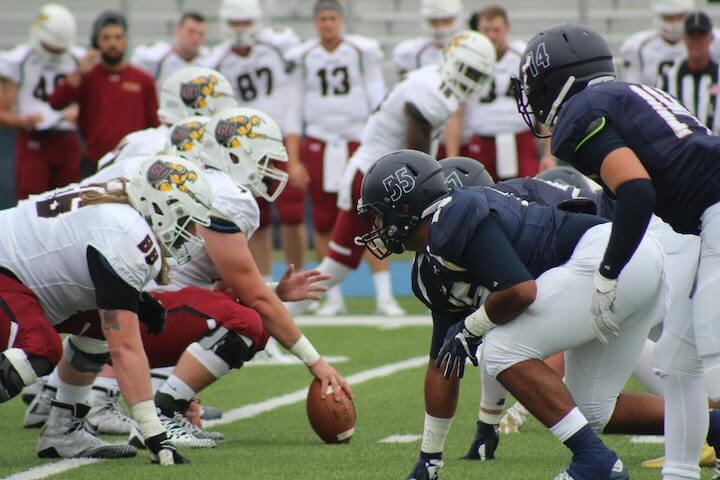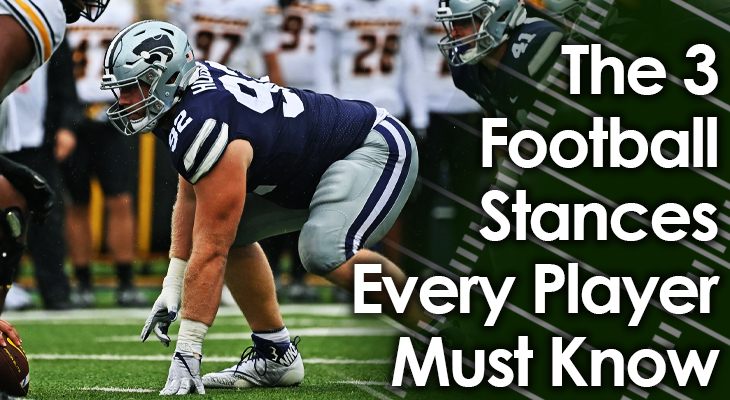No matter what position you play in football, you will set up in a specific stance before each play starts.
Your stance, or the way you position your body, will help you get off on the correct foot when the play begins.
There are three main football stances.
Understanding all three stances and what their strengths and weaknesses are is important so you know which stance to use (and when to use it) during a game.
Below, we'll dive into the basics of the three football stances, as well as describe some of the pros and cons of each.
What is a Football Stance?
A football stance is the way a player will position himself before a play begins.
It's a specific way players position their bodies to start the play off the best way they can.
The reason for the three different stances is that each position requires something a little different to start a play.
For example:
The stance offensive and defensive linemen use allows them to start plays lower and explode straight out so they can initiate contact immediately after the snap.
While a wide receiver's stance enables them to burst out to their passing routes right after the snap.
There are three different football stances as each position requires something a little different to start each play.

Types of Football Stances
Players typically won't use every stance in a game.
But it's still important for every player to learn each of the main football stances. This allows them to figure out which is best for them, based on their position, the game situation, and what they need to do on the particular play.
Understanding these stances will also help you anticipate what the player lined up across you will do.
Here are the 3 football stances every player must know:
a. 2-Point Stance
The 2 point stance is the most upright stance.
It's called a 2 point stance because players start with two 'points' touching the ground -- meaning both feet.
Defensive backs, linebackers, wide receivers, and running backs use this stance the most.
The 2 point stance allows these players to see more of the field as the quarterback goes through his cadence -- which is very important for what they do.
Being more upright rather than having a hand on the ground (as the two other stances do) also allows these players to get a quicker start right at the snap.
This is very important for the skill position players on offense who look to gain a step on their defensive counterparts.
And it's equally as important for defensive players covering them, for the same reason.
In today's game, some edge rushers and defensive ends will line up in a 2 point stance on obvious passing downs. This gives them a little bit of an advantage over offensive linemen as they try to rush the quarterback.
b. 3-Point Stance
You'll see the 3 point stance used most commonly by offensive and defensive linemen.
It involves the players touching the ground on three 'points' before the play -- two feet plus one hand.
By bending over at the waist and having one hand on the ground, it helps both offensive linemen and defensive linemen keep lower to the ground. This is essential in their aim to gain leverage on their counterpart.
The 3 point stance allows linemen to explode out of their stance at the snap, and to do so while keeping as low to the ground as possible.
This is very important for both all linemen, who must initiate the first contact with their opponent to try and knock them off balance and gain an advantage.
While some offensive tackles may align themselves in a 2 point stance on some plays -- or against some excellent outside rushing defenders -- most offensive linemen will be in the 3 point stance on every play.
c. 4-Point Stance
On some short-yardage situations, you might see offensive and defensive linemen use the 4-point stance.
This stance is similar to the 3 point stance, except players will put both of their hands on the ground.
This allows them to get even lower than the 3 point stance.
This is crucial in short-yardage situations where the offense will most likely try to run the ball straight ahead to either gain a first down or score a touchdown.
The 4 point stance was used a lot in football in the past, when offenses were very run-heavy.
We see it less and less in today's game, though, because so many offenses are going with smaller, faster lineups of players -- and because linemen are more athletic today.
That said, many youth football teams will have their players start with a 4 point stance since it's easy to teach, and because it helps players learn how to stay low.
And since a lot of youth football offenses still run the ball a lot, it's a stance that works well for linemen at this level.

Conclusion
Every player should learn the three football stances, regardless of what position they play.
Even though they may never use all three, it'll help them understand the strengths and weaknesses of each, and why they may or may not want to use one.
Coaches need to help players perfect their stances. How well players are able to perform on a particular play is determined a lot by how they line up before the play.

